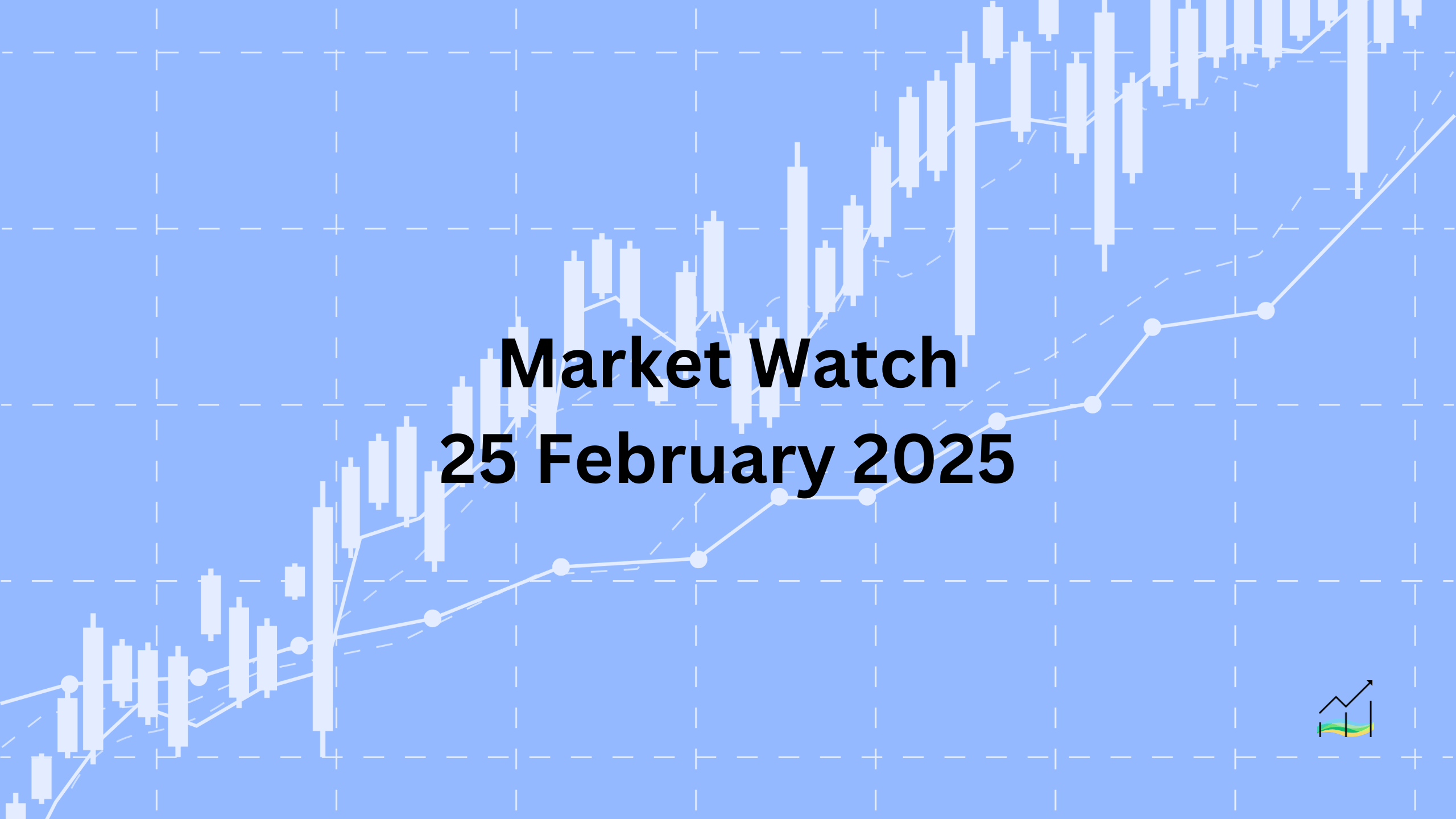25/02/2025 Market Watch

U.S. Yields Decline, Commodities Stabilize
The US 10-year Treasury yield has dropped to a two-month low near 4.33% ahead of a $70 billion five-year note auction. This follows strong demand in the recent two-year floating note sale. The 200-day moving average is around 4.25%, and the yield remains well below its mid-January peak of 4.80%. The dollar initially gained following remarks confirming that tariffs on Mexico and Canada were still in place. However, conflicting statements on the timeline limited follow-through gains. The dollar is mixed, with the dollar-bloc currencies under pressure, while most emerging market currencies are weaker, except for a few in Central Europe.
Asian bond markets responded to the US Treasury rally, with the 10-year JGB yield falling by nearly six basis points, while Australian and New Zealand yields declined by four basis points. European benchmark yields are slightly softer, mostly down by around one basis point. However, German Bund yields are rising on expectations of increased military spending, while UK 10-year Gilt yields have fallen by three basis points to 4.53%.
In commodities, gold is consolidating after reaching a record high above $2,956. Meanwhile, oil prices continue to recover, with April WTI rising to $71.25 after briefly dipping below $70. Resistance is expected in the $71.50–$71.60 range.
United States of America
Overview
The Dollar Index initially recovered after hitting a new low early yesterday but has since stalled just below 106.80. The dollar found support after remarks reaffirming that tariffs on Mexico and Canada remain on track. However, many see the tariff threats as a negotiation tactic. Reports indicate that Mexico is under pressure to raise tariffs on Chinese imports to avoid US-imposed tariffs, reinforcing the perception of ongoing trade tensions.
Economic Drivers
Concerns over trade policy are overshadowing economic data, with markets closely watching the potential for a broader trade war. Investor sentiment remains cautious, as uncertainty over tariffs and global trade policies weigh on the outlook.
Data and Events
Today’s US economic calendar includes multiple Federal Reserve surveys, covering Philadelphia non-manufacturing, Richmond manufacturing, and Dallas services. December house price data will also be released. Consumer confidence may be in focus after the University of Michigan’s sentiment index fell sharply last week, dropping to 64.7—the lowest level since November 2023. This decline worsened between the preliminary and final estimates, signaling growing caution among consumers.
February's non-farm payrolls are expected to remain steady at 143K, with the unemployment rate holding at 4.0%. However, labor market data currently takes a backseat to trade developments.
Price Action
The dollar's movement remains constrained by uncertainty around trade policy. Despite recovering from recent lows, gains have been limited as traders weigh the risks of escalating tariff conflicts.
Key Points:
- Dollar Index stalled below 106.80 after recovering from early lows.
- Tariff concerns dominate sentiment, with reports of pressure on Mexico to raise tariffs on Chinese imports.
- US data releases today include Fed surveys, house prices, and consumer confidence.
- Consumer confidence hit its lowest since November 2023, reflecting growing caution.
- Non-farm payrolls expected to remain steady at 143K, with unemployment at 4.0%.
Australia
Overview
The Australian dollar struggled to maintain momentum after briefly rising above $0.6400 last Thursday and Friday. This peak nearly reached the 38.2% retracement level from the sell-off that began after last September's high of approximately $0.6940. Despite holding above the pre-weekend low of around $0.6350, the currency faced follow-through selling, pushing it back down to last week's lows near $0.6325.
Economic Drivers
Australia's upcoming economic data is critical as it could influence the Australian dollar's performance. The January Consumer Price Index (CPI) is expected to show an uptick for the third consecutive month, rising from 2.5% in December 2024. A median forecast of 2.6% is anticipated, marking the highest inflation rate since last August. The futures market currently indicates about an 80% chance of a rate cut in May, but it is not fully priced in until July.
Data and Events
The release of the January CPI report will be crucial for assessing the economic landscape and could impact the Australian dollar's trajectory. Investors will be closely monitoring these figures for signs of inflation trends and potential shifts in monetary policy.
Price Action
After struggling to regain ground above $0.6400, the Australian dollar's recent selling pressure has brought it back to last week's lows. A break below this support level targets the $0.6285 area initially. Daily momentum indicators have not yet turned, but they appear poised to do so in the coming days, suggesting potential volatility ahead.
Key Points:
- Australian dollar stalls after reaching above $0.6400 but struggles to maintain momentum.
- Follow-through selling brings the currency back to last week's low near $0.6325.
- January CPI report expected to show an increase to 2.6%, the highest since last August.
- Futures market anticipates an 80% chance of a rate cut in May, fully priced in by July.
- Key support at $0.6325, with an initial target of $0.6285 if broken.
Canada
Overview
The US dollar rose sharply against the Canadian dollar, reaching nearly CAD1.4270 following President Trump's reaffirmation of tariffs. The greenback extended its gains today, reaching almost CAD1.4280, marking a new eight-day high. The 20-day moving average is positioned near CAD1.4300, and the dollar has not closed above this level since February 3.
Economic Drivers
The Canadian dollar appears vulnerable as several US tariffs are set to take effect next week. The upcoming trade disruptions are expected to have a more significant impact on the trajectory of monetary policy than the forthcoming GDP data. After a contraction of 0.2% in November, the Canadian economy is forecasted to grow by 0.3% in December, aided by the temporary suspension of the sales tax.
Data and Events
Canada's December and Q4 GDP data will be reported at the end of the week. These figures will provide insight into the health of the Canadian economy but may be overshadowed by trade developments from the US.
Price Action
After declining to CAD1.4150 on February 14—its lowest point in two months—the US dollar has mostly consolidated below CAD1.4250. Daily momentum indicators are showing signs of turning higher, which may support further gains for the greenback in the near term.
Key Points:
- US dollar rises to nearly CAD1.4280 after tariff confirmation from Trump.
- 20-day moving average is near CAD1.4300; the dollar hasn't closed above it since February 3.
- Canadian dollar vulnerable as US tariffs return next week.
- Canadian GDP expected to grow by 0.3% in December, following a 0.2% contraction in November.
- Trade disruptions likely to influence monetary policy more than upcoming GDP data.
China
Overview
China's economic calendar remains relatively light until the upcoming PMI data release this weekend. Despite some notable technological advancements, the economy has yet to demonstrate convincing forward momentum. Meanwhile, the US dollar has rebounded significantly, rising from around CNH7.2290 yesterday to nearly CNH7.2700 today.
Economic Drivers
While expectations for a small gain in the PMI indicate some optimism, broader economic indicators suggest that China is still navigating challenges. The lack of strong economic momentum could weigh on the yuan's performance in the coming days.
Data and Events
The PMI release this weekend will be a key data point for investors, providing insight into the health of China's manufacturing sector and overall economic activity.
Price Action
Following the US dollar's broad rebound, the next target for the dollar against the yuan is last week's high around CNH7.2865. The People's Bank of China (PBOC) set the dollar's reference rate at CNY7.1726 today, up from CNY7.1717 yesterday, marking the highest level since January 20.
Key Points:
- China's economic calendar is light until the PMI data release this weekend.
- US dollar rebounds from CNH7.2290 to nearly CNH7.2700.
- Next target for the dollar is last week's high around CNH7.2865.
- PBOC sets the dollar's reference rate at CNY7.1726, the highest since January 20.
- Economic momentum in China remains uncertain despite some technological successes.
Europe
Overview
The euro reversed course yesterday from nearly $1.0530, marking a marginal new high for the month. It has since found support slightly above $1.0450, with a break below this level targeting last week's low near $1.04 and then $1.0380.
Economic Drivers
Recent economic data presents a mixed picture for the eurozone. January car registrations, a proxy for sales, fell by 2.6% following a significant 5.1% increase in December, the strongest monthly gain since April 2024. Tesla's market share dropped to 1.0% in January from 1.8% a year prior, with sales plummeting 45% to 9.9k vehicles last month compared to 18.2k in January 2024. Additionally, the eurozone indicator of negotiated wages slowed to 4.1% year-over-year, down from 5.4% in Q3 2024, signaling potential implications for monetary policy.
Data and Events
Germany is reportedly considering passing a €200 billion defense bill under the current parliament rather than waiting for the new parliament, which does not convene until late March. This move could be met with opposition, affecting market sentiment.
Price Action
German Bund bonds are underperforming in today's trading, reflecting the uncertainties in the economic landscape and the potential impact of government policy on financial markets.
Key Points:
- Euro reverses from nearly $1.0530, finding support above $1.0450.
- January car registrations fell by 2.6% after a 5.1% increase in December.
- Tesla's market share dropped to 1.0% with a 45% decline in sales.
- Negotiated wage growth slows to 4.1% year-over-year, down from 5.4% in Q3 2024.
- Germany may pass a €200 billion defense bill under the current parliament.
- German Bund bonds are underperforming amid economic uncertainties.
Japan
Overview
The US dollar initially approached December's low around JPY148.65 but recovered to JPY149.80 yesterday. Following President Trump's tariff discussions, it climbed to approximately JPY150.30 early today before retreating to JPY149.20. The dollar found buying interest in early European trading, recovering to about JPY149.85. For a stronger technical outlook, the dollar needs to surpass the JPY150.40 to JPY150.75 range.
Economic Drivers
The dollar's strength is not significantly supported by the US 10-year yield, which has fallen to a new two-month low near 4.33%, down nearly 20 basis points from the end of January. Economic data is expected to play a critical role this week, particularly in Japan, where analysts anticipate softer Tokyo February CPI and a rebound in retail sales. There is also an expected third consecutive monthly decline in industrial production.
Data and Events
Surveys indicate that many expect the Bank of Japan (BOJ) to implement a rate hike in July, although the swaps market has not fully accounted for this until October. The upcoming economic reports will provide insight into Japan's economic performance and could influence monetary policy expectations.
Price Action
The dollar's recent volatility reflects ongoing market reactions to tariff talks and economic indicators, highlighting its dependency on broader financial conditions.
Key Points:
- Dollar rebounds from December's low around JPY148.65 to JPY149.80.
- Climbs to JPY150.30 after Trump’s tariff discussions before retreating to JPY149.20.
- Technical recovery needed above the JPY150.40-JPY150.75 area.
- US 10-year yield hits a new low at 4.33%, affecting dollar support.
- Japan's economic data expected this week includes softer CPI and retail sales rebound.
- Market anticipates BOJ rate hike in July, but swaps market reflects a later timeline.
United Kingdom
Overview
The British pound reached $1.2690 yesterday, marking a marginal high not seen since mid-December, before encountering selling pressure that pushed it down to nearly $1.2610. Today, it briefly dipped below this level but managed to hold above $1.2600. A sustained break below could target the $1.2550 to $1.2560 range initially.
Economic Drivers
This week, the economic data for the UK is relatively limited, with no major reports expected to influence market sentiment significantly. However, the political landscape is shifting, with Prime Minister Starmer’s upcoming visit to Washington on Thursday being the notable event.
Data and Events
Starmer's visit comes at a time when he has publicly endorsed Ukraine and President Zelenskyy, drawing parallels with historical instances when the UK suspended parliamentary elections for democratic reasons during WWII. His stance reinforces the importance of democratic processes even amid significant external threats, such as the ongoing conflict in Ukraine, which has contributed to the suspension of elections there due to martial law.
Price Action
The pound's fluctuations reflect the market's reaction to both political developments and economic indicators. Traders will be closely watching how the upcoming political events unfold and their potential impact on Sterling's performance.
Key Points:
- Sterling peaked at $1.2690 yesterday, a new high since mid-December.
- Sellers emerged, pushing the pound down to nearly $1.2610.
- Currently holds above $1.2600, but a break could target $1.2550-60.
- Limited economic data expected this week from the UK.
- Prime Minister Starmer's visit to Washington on Thursday is a key event.
- Starmer endorses Ukraine, drawing historical parallels to the UK’s past democratic decisions.
© 2025 SKONE Enterprise (003319453-V). All rights reserved.
The content on this site is for informational purposes only and does not constitute financial advice.


